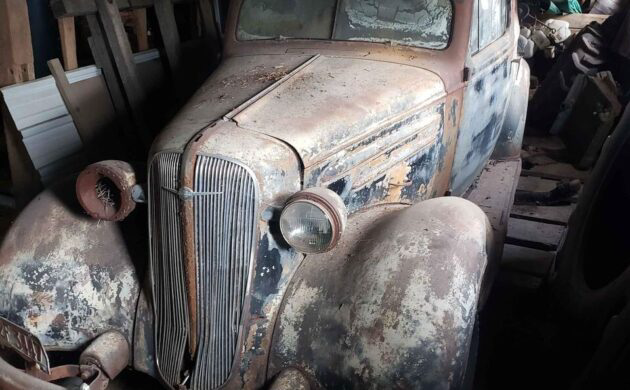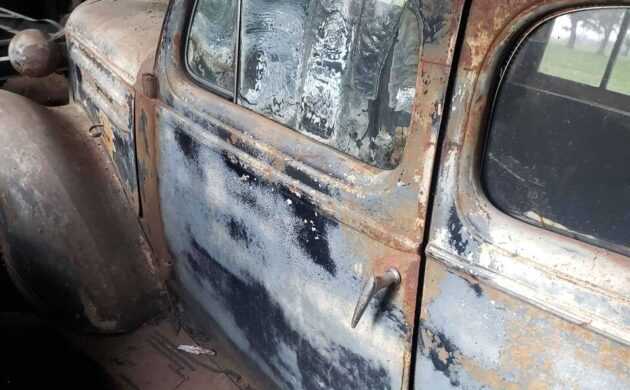15 Years In the Barn: 1936 Chevrolet “Standard”
Chevrolet would have a milestone year in 1936, beating Ford out for the #1 sales spot. That was no small feat considering that buyers finally had money to spend on new cars after The Great Depression ensued in 1929. Two models were offered, the Standard and Master Deluxe, with a 4-inch change in wheelbase to differentiate the two. The seller has a 2-door Standard sedan that’s been in storage for 15 years and comes with two engines. Located in Cannon Falls, Minnesota, this rolling project is available here on Facebook Marketplace for $3,500. Thanks for the cool tip, NW Iowa Kevin.
If you were on a budget in 1936 and wanted to buy a new Chevy, the Standard was your car (in production from 1933 and 1937). The Standard was available in five body styles and came equipped with an inline-6 engine that was good for nearly 80 hp using a single down-draft carburetor. The Standard was not as roomy as the Master as the wheelbase was 109 inches compared to the other at 113.
We’re told that when the seller acquired this Chevy, the original drivetrain was in pieces and is still in that condition today. You could attempt to rebuild this or go with the extra 1936 hardware that comes with the automobile, namely a spare engine, 3-speed transmission, rear end, and front axle. The dark surroundings in the photos suggest an incomplete car, but is it rusty? We don’t know. Like the drivetrain, the interior is in pieces, too, so it will also need lots of attention. If you like these post-Depression/pre-WW2 autos, would you want to tackle a restoration on this one?
Auctions Ending Soon
 1971 Ford Mustang Mach 1Bid Now3 hours$7,100
1971 Ford Mustang Mach 1Bid Now3 hours$7,100
 2003 Porsche Boxster SBid Now4 hours$6,500
2003 Porsche Boxster SBid Now4 hours$6,500
 1966 Lincoln ContinentalBid Now6 hours$500
1966 Lincoln ContinentalBid Now6 hours$500
 2000 Jaguar XJ8LBid Now4 days$1,250
2000 Jaguar XJ8LBid Now4 days$1,250
 1977 Datsun 280ZBid Now5 days$275
1977 Datsun 280ZBid Now5 days$275




Comments
Wooden guts on the inside ie: doors roof floor
Lots of fun filled multitudes of hours of fabricating enjoyment !
First the rust, then woodpeckers and termites. That poor car. Maybe in it’s next life, it’ll come back as a strainer..
1936 Chevies did have wood in the doors, but not the roof (first year for Chevy’s all steel, one-piece “Turret Top”) or the floors. My first car was a two-door Chevy Standard like the one for sale. Although not a race car, the 206.8 CI OHV six-cylinder engine stood up to the multitude of abuse I supplied. Can’t say the same for the clutch or the three transmissions I went through. It came in handy at the Senior Prom, however. The girl I had eyes for was dating the football star, but they broke up right before the prom. I boldly stepped forward and invited her to accompany me to the Prom in my ’36 Chevy. To my surprise she accepted, primarily, I assumed, to ride to the dance in my classic car. Much to our mutual chagrin the clutch went out just before Prom (I was trying to do burnouts with the stove bolt 6 cylinder). Our prom ride ended up being my brother’s 1966 pink Plymouth Valliant. I don’t think she could get home fast enough.
The 1936 Standard series wore Chevy’s all-steel “turret top” but body’s framework still used wood. The floor was all steel front to back. Both series also received hydraulic brakes that year. This car looks to be a Town Sedan. The sticker on the front license plate appears to read 53 or 63.
Ford outsold Chevrolet in the 1936 model year. For the calendar year Chevy out produced Ford.
To much fun in restoring this one, it would tickle me to death. Drainage of the bank account is to be considered. Needs everything from the tires to the paint. Interior will need all new stuff. Wiring will be garbage so that must be considered. Nice car when finished though.
My first car was a 35 standard 4 door sedan. Mechanical brakes on that one though.
Hope this one gets used for more than scrap iron. It will be expensive and time consuming. A frame off rotisserie acid dipped would be the way to go.
God Bless America
Grew up with my aunt’s ’36 Master Deluxe 4 door sedan. Mohair upholstery, crank vent windows, front and rear, lots of leg room in back (but I was smaller then), reliable, she bought it in ’36 and commuted in it until ’54 when she traded in for a used ’51. Rust killed it. And, having grown up with a Maxwell, she could use the crank (which lived in the trunk) to start it if the battery would not.
Crush it
Cool, the beauty of today’s technology you can have round or square steel or aluminum made to replace the wood structure and wind up with a nice ride
Starting my senior year in Oregon, 1950-51, I was looking for a car so I would not have to ride the school bus. I saw a 1936 Chev Standard advertised for $95. My older brother and I went out to check it. We looked it over, started the engine, and I told the owner I would take it. “Don’t you want to drive it,” he asked. It was my first car purchase, and I didn’t know whether he would let me take it for a spin. I don’t think I even kicked the tires. The car lasted through my senior year. Well, not always running. And I rode the bus more than I thought I would. $3,500 for this one? Back in 1950 the price in this condition might have been $10. It means a lot of work and money. But I would like to see it after someone takes the challenge.